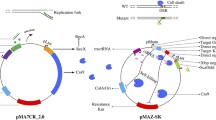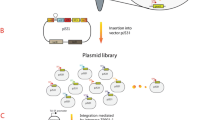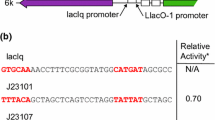Abstract
The interest in plasmid DNA (pDNA) as a biopharmaceutical has been increasing over the last several years, especially after the approval of the first DNA vaccines. New pDNA production strains have been created by rationally mutating genes selected on the basis of Escherichia coli central metabolism and plasmid properties. Nevertheless, the highly mutagenized genetic background of the strains used makes it difficult to ascertain the exact impact of those mutations. To explore the effect of strain genetic background, we investigated single and double knockouts of two genes, pykF and pykA, which were known to enhance pDNA synthesis in two different E. coli strains: MG1655 (wild-type genetic background) and DH5α (highly mutagenized genetic background). The knockouts were only effective in the wild-type strain MG1655, demonstrating the relevance of strain genetic background and the importance of designing new strains specifically for pDNA production. Based on the obtained results, we created a new pDNA production strain starting from MG1655 by knocking out the pgi gene in order to redirect carbon flux to the pentose phosphate pathway, enhance nucleotide synthesis, and, consequently, increase pDNA production. GALG20 (MG1655ΔendAΔrecAΔpgi) produced 25-fold more pDNA (19.1 mg/g dry cell weight, DCW) than its parental strain, MG1655ΔendAΔrecA (0.8 mg/g DCW), in glucose. For the first time, pgi was identified as an important target for constructing a high-yielding pDNA production strain.


Similar content being viewed by others
References
Ahn J, Chung BKS, Lee DY, Park M, Karimi IA, Jung JK, Lee H (2011) NADPH-dependent pgi-gene knockout Eschericha coli metabolism producing shikimate on different carbon sources. FEMS Microbiol Lett 324:10–16
Azzoni AR, Ribeiro SC, Monteiro GA, Prazeres DMF (2007) The impact of polyadenylation signals on plasmid nuclease-resistance and transgene expression. J Gene Med 9:392–402
Baba T, Ara T, Hasegawa M, Takai Y, Okumura Y, Baba M, Datsenko KA, Tomita M, Wanner BL, Mori H (2006) Construction of Escherichia coli K-12 in-frame, single-gene knockout mutants: the Keio collection. Mol Syst Biol 2:2006–2008
Bower DM, Prather KLJ (2009) Engineering of bacterial strains and vectors for the production of plasmid DNA. Appl Microbiol Biotechnol 82:805–813
Canonaco F, Hess TA, Heri S, Wang T, Szyperski T, Sauer U (2001) Metabolic flux response to phosphoglucose isomerase knock-out in Escherichia coli and impact of overexpression of the soluble transhydrogenase UdhA. FEMS Microbiol Lett 204(2):247–252
Carnes AE, Williams JA (2007) Plasmid DNA manufacturing technology. Recent Pat Biotechnol 1(2):1–16
Carnes AE, Hodgson CP, Williams JA (2006) Inducible Escherichia coli fermentation for increased plasmid DNA production. Biotechnol Appl Biochem 45:155–166
Carnes AE, Luke JM, Vincent JM, Shukar A, Anderson S, Hodgson CP, Williams JA (2011) Plasmid DNA fermentation strain and process-specific effects on vector yield, quality, and transgene expression. Biotechnol Bioeng 108(2):354–363
Carvalho RJ, Cabrera-Crespo J, Tanizaki MM, Goncalves VM (2012) Development of production and purification processes of recombinant fragment of pneumococcal surface protein A in Escherichia coli using different carbon sources and chromatography sequences. Appl Microbiol Biotechnol 94:683–694
Charusanti P, Conrad TM, Knight EM, Venkataraman K, Fong NL, Xie B, Gao Y, Palsson BO (2010) Genetic basis of growth adaptation of Escherichia coli after deletion of pgi, a major metabolic gene. PLoS Genet 6(11):e1001186
Chin JW, Cirino PC (2011) Improved NADPH supply for xylitol production by engineered Escherichia coli with glycolytic mutations. Biotechnol Prog 27(2):333–341
Chin JW, Khankal R, Monroe CA, Maranas CD, Cirino PC (2009) Analysis of NADPH supply during xylitol production by engineered Escherichia coli. Biotechnol Bioeng 102(1):209–220
Cunningham DS, Koepsel RR, Ataai MM, Domach MM (2009a) Factors affecting plasmid production in Escherichia coli from a resource allocation standpoint. Microb Cell Fact 8:1–27
Cunningham DS, Liu Z, Domagalski N, Koespsel RR, Ataai MM, Domach MM (2009b) Pyruvate kinase-deficient Echerichia coli exhibits increased plasmid copy number and cyclic AMP levels. J Bacteriol 191(9):3041–3049
Datsenko KA, Wanner BL (2000) One-step inactivation of chromosomal genes in Escherichia coli K-12 using PCR products. Proc Natl Acad Sci U S A 97(12):6640–6645
De Anda R, Lara AR, Hernandez V, Hernandez-Montalvo V, Gosset G, Bolivar F, Ramirez OT (2006) Replacement of the glucose phosphotransferase transport system by galactose permease reduces acetate accumulation and improves process performance of Escherichia coli for recombinant protein production without impairment of growth rate. Metab Eng 8(3):281–290
Flores S, Anda-Herrera R, Gosset G, Bolívar FG (2004) Growth-rate recovery of Escherichia coli cultures carrying a multicopy plasmid, by engineering of the pentose–phosphate pathway. Biotechnol Bioeng 87(4):485–494
Goncalves GA, Bower DM, Prazeres DM, Monteiro GA, Prather KL (2012) Rational engineering of Escherichia coli strains for plasmid biopharmaceutical manufacturing. Biotechnol J 7:251–261. doi:10.1002/biot.201100062
Han Y, Liu S, Ho J (2009) Using DNA as a drug—bioprocessing and delivery strategies. Chem Eng Res Des 87:343–348
Lara AR, Ramirez OT (2012) Plasmid DNA production for therapeutic applications. Methods Mol Biol 824:271–303
Lara AR, Knabben I, Regestein L, Sassi J, Caspeta L, Ramırez OT, Buchs J (2011) Comparison of oxygen enriched air vs. pressure cultivations to increase oxygen transfer and to scale-up plasmid DNA production fermentations. Eng Life Sci 11(4):382–386
Listner K, Bentley LK, Chartrain M (2006) A simple method for the production of plasmid DNA in bioreactors. Methods Mol Med 127:295–309
Luke J, Carnes AE, Hodgson CP, Williams JA (2009) Improved antibiotic-free DNA vaccine vectors utilizing a novel RNA based plasmid selection system. Vaccine 27:6454–6459
Luli GW, Strohl WR (1990) Comparison of growth, acetate production and acetate inhibtion of Escherichia coli strains in batch and fed-batch fermentations. Appl Environ Microbiol 56:1004–1011
Morita T, El-Kazzaz W, Tanaka Y, Inada T, Aiba H (2003) Accumulation of glucose 6-phosphate or fructose 6-phosphate is responsible for destabilization of glucose transporter mRNA in Escherichia coli. J Biol Chem 278(18):15608–15614
Oh M, Liao JC (2000) Gene expression profiling by DNA microarrays and metabolic fluxes in Escherichia coli. Biotechnol Prog 16:278–286
O'Kennedy RD, Ward JM, Keshavarz-Moore E (2003) Effects of fermentation strategy on the characteristics of plasmid DNA production. Biotechnol Appl Biochem 37(Pt 1):83–90
Ow DS-W, Lee RM-Y, Nissom PM, Philp R (2007) Inactivating FruR global regulator in plasmid-bearing Escherichia coli alters metabolic gene expression and improves growth rate. J Biotechnol 131:261–269
Ow DS-W, Yap MG-S, Oh SK-W (2009) Enhancement of plasmid DNA yields during fed-batch culture of a fruR-knockout Escherichia coli strain. Biotechnol Appl Biochem 52:53–59
Pablos TE, Soto R, Mora EM, Le Borgne S, Ramirez OT, Gosset G, Lara AR (2011) Enhanced production of plasmid DNA by engineered Escherichia coli strains. J Biotechnol 158:201–212
Phalakornkule C, Lee S, Zhu T, Koepsel R, Ataai MM, Grossmann IE, Domach MM (2001) A MILP-based flux alternative generation and NMR experimental design strategy for metabolic engineering. Metab Eng 3(2):124–137
Phue J, Noronha SB, Hattacharyya R, Wolfe AJ, Shiloach J (2005) Glucose metabolism at high density growth of E. coli B and E. coli K: differences in metabolic pathways are responsible for efficient glucose utilization in E. coli B as determined by microarrays and Nothern blot analyses. Biotechnol Bioeng 90(7):805–820
Phue J-N, Lee SJ, Trinh L, Shiloach J (2008) Modified Escherichia coli B (BL21), a superior producer of plasmid DNA compared with Escherichia coli K (DH5a). Biotechnol Bioeng 101(4):831–836
Prather KJ, Sagar S, Murphy J, Chartain M (2003) Industrial scale production of plasmid DNA for vaccine and gene therapy: plasmid design, production, and purification. Enzyme Microb Technol 33:865–883
Prazeres DMF (2011) Plasmid biopharmaceuticals: basics. Applications and manufacturing. Wiley, Hoboken, NJ
Siddiquee KA, Arauzo-Bravo MJ, Shimizu K (2004a) Effect of a pyruvate kinase (pykF-gene) knockout mutation on the control of gene expression and metabolic fluxes in Escherichia coli. FEMS Microbiol Lett 235(1):25–33
Siddiquee KAZ, Arauzo-Bravo MJ, Shimizu K (2004b) Metabolic flux analysis of pykF gene knockout Escherichia coli based on 13C-labeling experiments together with measurements of enzyme activities and intracellular metabolite concentrations. Appl Microbiol Biotechnol 63:407–417
Siedler S, Bringer S, Bott M (2011) Increased NADPH availability in Escherichia coli: improvement of the product per glucose ratio in reductive whole-cell biotransformation. Appl Microbiol Biotechnol 92(5):929–937
Soto R, Caspeta L, Barrón B, Gosset G, Ramírez OT, Lara AR (2011) High cell-density cultivation in batch mode for plasmid DNA production by a metabolically engineered E. coli strain with minimized overflow metabolism. Biochem Eng J 56:165–171
Summers D (1998) Timing, self-control and a sense of direction are the secrets of multicopy plasmid stability. Mol Microbiol 29:1137–1141
Wang Z, Xiang L, Shao J, Wegrzyn A, Wegrzyn G (2006) Effects of the presence of ColEI plasmid DNA in Escherichia coli on the host cell metabolism. Microb Cell Fact 5:34
Williams JA, Carnes AE, Hodgson CP (2009a) Plasmid DNA vaccine vector design: impact on efficacy, safety and upstream production. Biotechnol Adv 27(4):353–370
Williams JA, Luke J, Langtry S, Anderson S, Hodgson CP, Carnes AE (2009b) Generic plasmid DNA production platform incorporating low metabolic burden seed-stock and fed-batch fermentation processes. Biotechnol Bioeng 103(6):1129–1143
Wolff AJ, Malone RW, Williams P, Chong W, Acsadi G, Jani A (1990) Direct gene transfer into mouse muscle in vivo. Science 247:1465–1468
Yao R, Hirose Y, Sarkar D, Nakahigashi K, Ye Q, Shimizu K (2011) Catabolic regulation analysis of Escherichia coli and its crp, mlc, mgsA, pgi and ptsG mutants. Microb Cell Fact 10:67
Zhi-nan X, Wen-he S, Hao C, Pei-lin C (2005) Effects of medium composition on the production of plasmid DNA vector potentially for human gene therapy. J Zhejiang Univ Sci B 6(5):396–400
Acknowledgments
This work was supported by the MIT-Portugal Program and Fundação para a Ciência e a Tecnologia (project PTDC/EBB-EBI/113650/2009 PhD grant SFRH/BD/33786/2009 to Geisa A. L. Gonçalves). We also acknowledge Kevin Solomon (MIT) for providing the plasmid pKD46recA+, Sang-Hwal Yoon (MIT) for constructing MG1655ΔendAΔrecA, and Diana Bower (MIT) for the development of HPLC methods. Special acknowledgment to all members of the Prather Research Group for providing helpful insights that contributed to this work.
Conflict of interest
The authors have declared no conflict of interest.
Author information
Authors and Affiliations
Corresponding author
Rights and permissions
About this article
Cite this article
Gonçalves, G.A.L., Prazeres, D.M.F., Monteiro, G.A. et al. De novo creation of MG1655-derived E. coli strains specifically designed for plasmid DNA production. Appl Microbiol Biotechnol 97, 611–620 (2013). https://doi.org/10.1007/s00253-012-4308-5
Received:
Revised:
Accepted:
Published:
Issue Date:
DOI: https://doi.org/10.1007/s00253-012-4308-5




